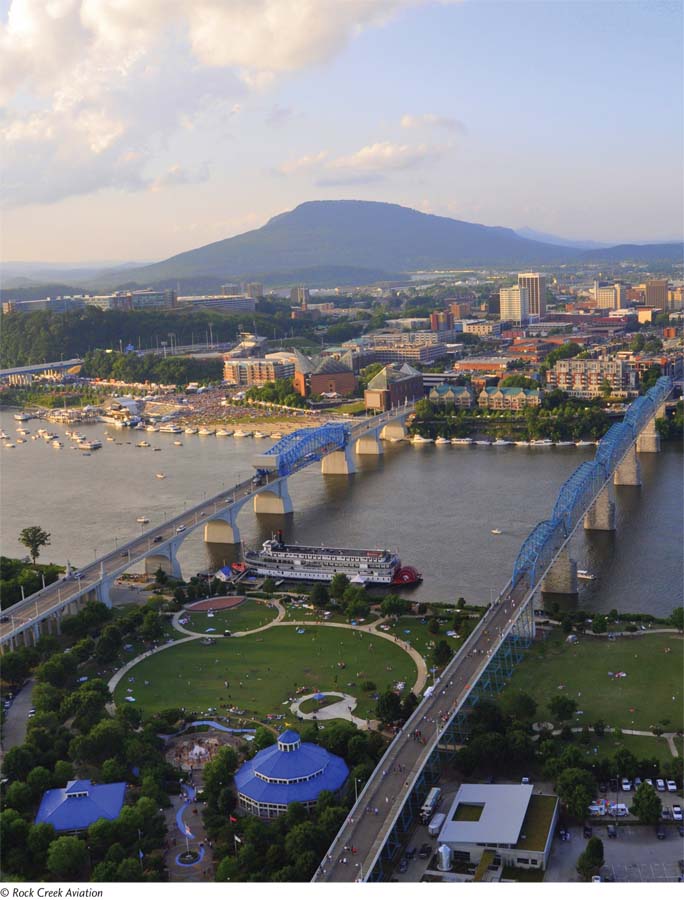Chapter Introduction
chapter 15
Air Pollution and Stratospheric Ozone Depletion

Cleaning Up in Chattanooga
The summer of 2012 was not kind to Chattanooga, Tennessee. Dust storms in the West led to a number of poor air quality days in a city that is generally known for very good air quality. Chattanooga sits along the Tennessee River in a natural basin formed by the Appalachian Mountains, one of which—
By 1957, Chattanooga had the third-
The economic boom in Chattanooga had an environmental cost. Like Los Angeles and many other highly polluted cities, Chattanooga is located in a bowl formed by surrounding mountains. This geography traps pollutants that hover above the city. By 1957, Chattanooga had the third-
Obviously the poor quality of the air needed to be addressed. In 1969, Chattanooga, in conjunction with Hamilton County, created its own air pollution legislation by enacting the Air Pollution Control Ordinance. It controlled the emissions of sulfur oxides, allowed open burning by permit only, placed regulations on odors and dust, outlawed visible automobile emissions, capped the sulfur content of fuel at 4 percent, and limited visible emissions from industry. At the same time, the city and county governments put in place new pollution monitoring techniques to make sure the ordinance was being followed.
The city and county governments, along with private industry, poured approximately $40 million into the cleanup effort. Actions to improve air quality did not hinder business, as some people feared, but rather created new industrial opportunities related to the cleanup effort, such as the establishment of a local manufacturer of smokestack scrubbers. As a result of all these measures, in 1972—
The people of Chattanooga and the local governments recognized that keeping their air clean and maintaining economic sustainability would be an ongoing effort. To maintain their newly improved air quality, the city government and local businesses began several programs. One such program was a comprehensive recycling program, chosen as an alternative to a waste incinerator that would have added particles to the air. Public and private sectors successfully partnered to achieve both environmental and economic sustainability in creating the largest municipal fleet of electric buses in the United States, manufactured by another local business.
Unfortunately, while Chattanooga’s efforts dramatically reduced the levels of particulate pollutants, the concentration of ozone, mostly from automotive pollutant precursors within and beyond the city limits, continued to climb. Ozone concentrations exceeded the 1997 standard of 0.08 parts per million by volume set by the Environmental Protection Agency. Chattanooga has responded to the new air pollution problem in the same way it faced the particulate pollutant problem of the 1960s—
Chattanooga attained the 0.08 parts per million standard in 2007, two years ahead of schedule. However, national legislation has since lowered the ozone standard to 0.075 parts per million. In 2011, before the dust storms from the West, Chattanooga met the new, lower ozone standard. However, residents know that to achieve their goals of an economically vibrant city with clean air, they must continue to encourage cooperation among government, people, and business. They also need fewer dust storms from the West.
Sources: Chattanooga Area Chamber of Commerce, Summary of the Chattanooga Area Chamber of Commerce’s Position on Strengthening the National Ambient Air Quality Standard for Ozone, 2010, www.chattanoogachamber.com; National Ambient Air Quality Standards: www.epa.gov/
Throughout this book, we have identified a number of systems that cover relatively small aspects of the natural and human worlds. Because air is a common resource across Earth, air pollution crosses many system boundaries. Human activity contributes to both outdoor and indoor air pollution. To understand air pollution and its effects, we need to look at all air pollutants, where they come from, and what happens to them after they are released into the atmosphere. In this chapter, we will identify the major air pollutants found around the globe and we will examine the specific air pollution situations that occur with photochemical smog and acid deposition. We will review a variety of air pollution control measures and examine stratospheric ozone depletion. We conclude the chapter with a discussion of indoor air pollution.